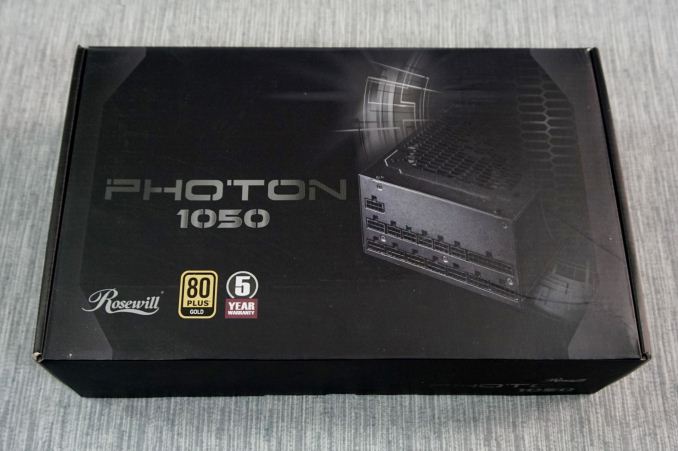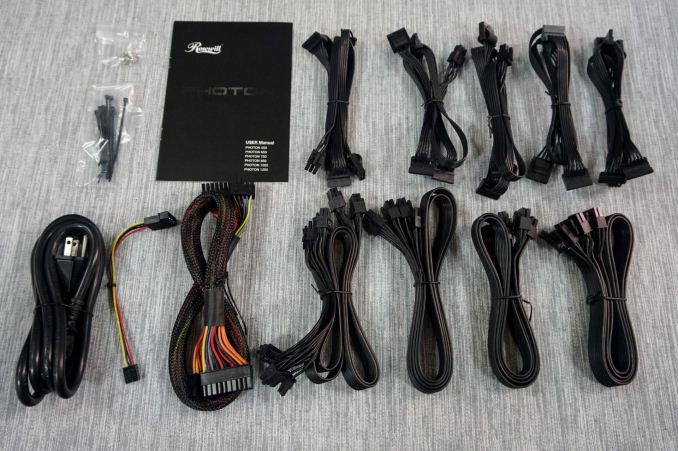The Rosewill Photon 1050W Review
by E. Fylladitakis on March 24, 2015 8:00 AM EST- Posted in
- Cases/Cooling/PSUs
- Rosewill
- 1050W
- Sirfa

Introduction
Rosewill is a company that started as a subsidiary and house brand of Newegg, focusing on simple components and hardware at very competitive prices. In time, the company fledged into a stand-alone company and expanded their product ranks to include a myriad of products from simple cables and adapters to advanced computer hardware, home appliances and office products. The sheer number of products Rosewill markets today is bordering on ridiculous. Nevertheless the company is strongly localized, with their products readily available only in the North American markets. Rosewill is making moves to enter other regions and some, but not all, of their products can also be found in Southeast Asia, Japan, China and Australia.
Today we will be having a look at the Rosewill Photon 1050W. This is the second model of the Photon PSU series which is aimed to advanced users and gamers. All the units of the Photon series are 80Plus Gold certified, have a single 12V rail and are fully modular without any hardwired cables. It is a large series, with units ranging from 550W up to 1200W - it is therefore extremely likely that not all of the units are based on the same platform, or even that they come from the same OEM. Therefore the results of this review should not be extended to reflect the performance of other units of the series.
The unit retails for $140 including shipping and the 1050W version of the Photon is significantly cheaper than most competitive products. The 1050W unit that we will review today boasts good features and warranty for its price range, yet there is a catch: it is rated for 1050W output at 40°C. This is not in any way illegal, as this is the normal rating for the operating temperature of consumer PSUs, but most of the competition rates their high performance units at 50°C. We do perform out hot testing with >45°C ambient temperature and as such we will soon see where the Photon 1050W truly stacks against the competition.
| Power specifications ( Rated @ 40 °C ) | |||||
| AC INPUT | 100 - 240 VAC, 50 - 60 Hz | ||||
| RAIL | +3.3V | +5V | +12V | +5Vsb | -12V |
| MAX OUTPUT | 25A | 25A | 87.5A | 4A | 0.3A |
| 130W | 1050W | 20W | 3.6W | ||
| TOTAL | 1050W | ||||
Packaging and Bundle
Rosewill supplies the Photon 1050 in a fairly sturdy cardboard box, with a simple and very dark artwork theme. The artwork is focused on a picture of the unit itself, surrounded by abstract imagery. Very basic information about the PSU and its features can be found around the sides of the box.
The bundled items are few, limited to some very short cable ties, four normal screws, an AC power cable and a very basic manual. The manual is so plain that the user would have to seek detailed information elsewhere, such as Rosewill's website. With the exception of the typical sleeved ATX 24-pin cable, the rest of the cables are "flat", ribbon-like, with black wires. There also is a very basic Molex to Floppy adapter, for those that still own legacy devices and want to power them with a $140 PSU.












42 Comments
View All Comments
DanNeely - Tuesday, March 24, 2015 - link
Am I correct in thinking that this PSU, and other recent models capable of producing their entire output rating at 12V (give or take rounding on the amperage) are pure 12V designs internally that then use DC-DC converters to make the 3.3/5V rails instead of the traditional design that had separate circuitry for the 3.3/5v and 12v rail. With the older design having problems in cross load tests (when one side was maxed and the other only had a minimum load), the change in design seems a reasonable way to handle the shift of almost everything on the mobo to 12V operation; but I haven't seen it confirmed anywhere.MrCommunistGen - Tuesday, March 24, 2015 - link
Yes, many modern power supplies are built on a platform that only does AC to 12V DC, then use DC to DC conversion to get the 5V and 3.3V rails. I can think of all kinds of reasons that might provide cleaner power or be more efficient, but I'll leave that discussion to the experts.DanNeely - Tuesday, March 24, 2015 - link
Is the -12V (used for RS232) done that way too, or does it still get a special side circuit like the 5V standby.Gigaplex - Tuesday, March 24, 2015 - link
Why are the PSU reviews disproportionately focusing on 1kW and higher units? Even a high end SLI/Crossfire rig will struggle to load these PSUs. Especially with Intel and NVIDIAs latest power efficient architecture. How about some more reviews on units likely to be utilised by us mere mortals not doing quad Titan SLI?chlamchowder - Tuesday, March 24, 2015 - link
I agree. It's cool to read about ridiculously high end units. But few people are using dual graphics cards, and even fewer are going with more. I'd love to see reviews on lower priced units.For example, I recently built a computer with <400W power requirements. So, I got a $40 EVGA 500W supply - the cheapest 80+ supply I could find. There were approximately zero reviews of that unit on review sites (but plenty of user reviews on Newegg, for what that's worth).
For anyone who's wondering, that supply (100-W1-0500-KR R) is nice and quiet, even when feeding an overclocked FX-8350.
TomWomack - Tuesday, March 24, 2015 - link
I agree entirely; a review of PSUs starting from the absolutely cheapest, determining which ones work adequately, would be really useful. An i7/4790K with 16G memory and an SSD is a 150W system; to learn, with the kind of confidence that one of Anandtech's comprehensive reviews provide, that a $20 PSU from newegg is adequate would be quite helpful.jabber - Tuesday, March 24, 2015 - link
Hear hear! The number of people who look at this site that really really need such a PSU is probably less than 5%. Please lets have more reviews in the 450-750W range.jabber - Tuesday, March 24, 2015 - link
Oh and some nice reviews of specialist 200-400W would be good too.FunBunny2 - Saturday, March 28, 2015 - link
Yeah, but... AT's New Overseers clearly are going down the Apple Road: cater to the 20% rich and dumb enough to drop large coin on useless bling.gsuburban - Sunday, June 28, 2015 - link
Agreed. I don't use graphics cards any longer for computing, Intel HD Graphics will do. Thus, a PSU's total wattage isn't a main focus while the quality of it is. 650 watts is our limit in the long run for a non-discrete graphics machine and 750 to 850 with one.